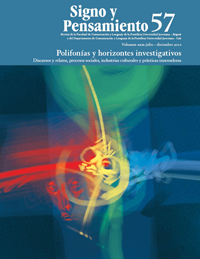Abstract
This article analyze the “Indian ethnic-art” from the concepts of symbolic value and economic value, sign value and symbol value, and study the transformation of the ethnic-art into a touristic souvenir. The purpose is to go deep in this subject, taking as theoretical assumptions the social representations and significations of the manifestations and traditions of the native brazilian culture. At the end, the article explores the changes caused by the market and the tourism.
Arizpe, L. y Alonso, G. (2001), “Cultura, comercio y globalización”, en: Mato, D. Estudios Latinoamericanos sobre cultura y transformaciones sociales en tiempos de globalización 2, disponible en: http://bibliotecavirtual.clacso. org.ar/ar/libros/mato2/arizpeealonso.pdf, recuperado el: 13 de agosto de 2010.
Azevedo Luíndia, L. (2005), Ecoturismo de Grupos Indígenas: ¿experiencias sostenibles? Tesis. Belém (PA). Núcleo de Altos Estudios Amazónicos. Universidad Federal de Pará.
— (2007), Ecoturismo Indígena. Quito, Abya-Yala.
— (2008), “Reapropiación de los recursos naturales y culturales a través de las experiencias de ecoturismo indígena: Kapawi/Ricancie/ NapoWildlifeCenter (Ecuador); Kuna Yala (Panamá); Bri-bri (Costa Rica); Reserva Pataxó da Jaqueira (Brasil); Pucani y Heath Wildlife Center (Perú).”, en: Weiss, J. S.; Bustamante; T. (eds.). Ajedrez ambiental: manejo de recursos naturales, comunidades, conflictos y cooperación, Quito, flacso.
Baudrillard, J. (2010), Crítica de la economía política del signo, México, Siglo xxi. — (1993), Cultura y Simulacro. Barcelona, Editorial Cairos.
— (2009), La Sociedad De Consumo. México, Siglo xxi.
— (2010), El sistema de los objetos. México, Siglo xxi.
Bauman, Z. (1998), O mal - estar da Pós-Modernidade. Rio de Janeiro, Editora Zahar.
— (1999), Modernidade e Ambivalência, Rio de Janeiro, Editora Zahar. Bourdieu, P. (2006), O poder simbólico. Rio de Janeiro, Editora Difel.
— (1990), Sociologia y Cultura, México, Grijalbo.
— (2007), A economia das trocas simbólicas. São Paulo, Perspectiva.
Castells, M. (1997), O poder da identidade, São Paulo, Paz e Terra.
Cohen, E. (1988), “Traditions in qualitative socialogy of tourismo”, en: Annals of Tourism Research, núm. 16, vol. 1, pp. 29-46.
— (1993), “Investigating tourism arts”, en: Annals of Tourism Research, núm. 20, pp. 1-8.
Cuartas, G. (2007), “Proyectos comunicativos y conformación grupal.”, en Revista Razón y Palabra, núm. 66, disponible en: http//:razonypalaba. org.mx/n66/actual/gvelez.pdf
Featherstone, M, (1995). Cultura de Consumo e Pós-Modernismo. São Paulo, Studio Nobel.
— (1998), Cultural Global: nacionalismo, globalização e modernidade, Petrópolis, Vozes.
García Canclini, N. (2006), Culturas híbridas. Estrategias para entrar y salir de la modernidad. Barcelona, Paidós.
— (2004), Diferentes, desiguales y desconectados: mapas de la interculturalidad. Barcelona, Gedisa Editorial.
Giddens, A. (1993). As conseqüências da modernidade. São Paulo, editora da unesp.
Gómez, P. (2008), Representaciones y ciencias sociales: una perspectiva epistemológica y metodológica. Buenos Aires, Espacio Editorial.
Jameson, F. (1993), “Conflictos interdisciplinarios en la investigación sobre la cultura”, en: Alteridades, núm. 5, pp.99-117.
Lyotard, J. F. (2008), La condición Pos moderna. Argentina, Rei.
Maffesoli, M. (2004), El nomadismo. Vagabundeos iniciáticos. México, fce.
Orlandi, E. P. (1998), Discurso & Leitura. Campinas, Cortez Editora.
Pignatari, D. (2002), Informação, linguagem, comunicação, São Paulo, Ateliê.
Santana, A. (1977), Antropología y turismo: ¿nuevas bordas, viejas culturas?, Barcelona, Ariel Antropología.
Sodré, M. (1996), Reiventando a cultura: a comunicação e seus produtos, Petropólis, Vozes.
Smith, V. (1992), “El turismo esquimal: micromodelos y marginación”, en smith, v. l. (ed.). Anfitriones e invitados, pp. 99-137, Madrid, Endimión.
Thompson, J. B. (1995), Ideologia e Cultura Moderna: teoria social crítica na era dos meios de comunicação de massa. Petropólis, RJ: Vozes.
— (1998), A mídia e modernidade: uma teoria social da mídia. Petrópolis, Vozes.
Velthem, L. (2003), O belo é a fera: a estética da produção e da predação entre os Waynana. Lisboa, Museu Nacional de Etnologia Assírio & Alvim.
This journal is registered under a Creative Commons Attribution 4.0 International Public License. Thus, this work may be reproduced, distributed, and publicly shared in digital format, as long as the names of the authors and Pontificia Universidad Javeriana are acknowledged. Others are allowed to quote, adapt, transform, auto-archive, republish, and create based on this material, for any purpose (even commercial ones), provided the authorship is duly acknowledged, a link to the original work is provided, and it is specified if changes have been made. Pontificia Universidad Javeriana does not hold the rights of published works and the authors are solely responsible for the contents of their works; they keep the moral, intellectual, privacy, and publicity rights.
Approving the intervention of the work (review, copy-editing, translation, layout) and the following outreach, are granted through an use license and not through an assignment of rights. This means the journal and Pontificia Universidad Javeriana cannot be held responsible for any ethical malpractice by the authors. As a consequence of the protection granted by the use license, the journal is not required to publish recantations or modify information already published, unless the errata stems from the editorial management process. Publishing contents in this journal does not generate royalties for contributors.


